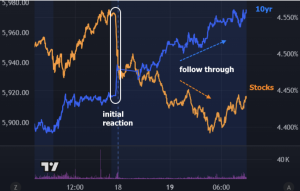On Friday, Moody’s dropped a financial truth bomb: a credit rating cut for the U.S. government. The announcement landed right before the trading bell—too late for most U.S. traders to react. But the global markets? They had the whole weekend to stew, and when the doors opened overseas, they made their voices heard loud and clear.

Now let’s be real: this downgrade isn’t breaking news in the grand scheme of things. Moody’s was just the last of the big three rating agencies to pull the trigger. The market didn’t flinch because of Moody’s itself—it flinched because the truth behind that downgrade is impossible to ignore.
This isn’t about politics. It’s about performance.
Global investors are looking at the U.S. like, “Really? Again?” Budget battles, debt ceiling drama, and deficit spending with no plan in sight… It’s the fiscal version of showing up to a black-tie event in gym shorts.
And the bond market? It’s not clapping. It’s booing. Loudly.
This isn’t a technical correction. This is a full-blown protest from global capital. The U.S. government keeps avoiding the hard conversations, and that’s scaring the people who actually hold our debt—foreign governments, hedge funds, pension managers.
Why does this matter to you?
Because when the global bond market loses faith in America’s fiscal responsibility, it gets expensive for all of us. Higher yields. Higher mortgage rates. Higher costs to borrow—whether you’re buying a home, funding a business, or refinancing debt.
And let’s not sugarcoat it: when the world sees us as a risky bet, we all pay the price.
So no, Moody’s isn’t the villain here. They’re just the guy in the back row yelling what everyone else is already thinking. The real issue is our nation’s lack of a sustainable fiscal strategy. And until that changes, expect more boos from the global balcony.
This is why I always say: control what you can control. Get your financing locked in when rates make sense. Don’t wait for Washington to figure it out. If you’re thinking about buying, refinancing, or expanding, let’s talk strategy before the market moves again.
